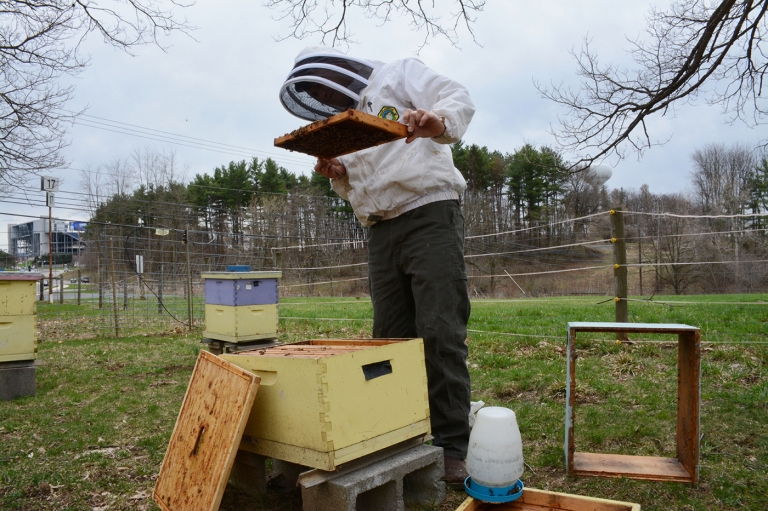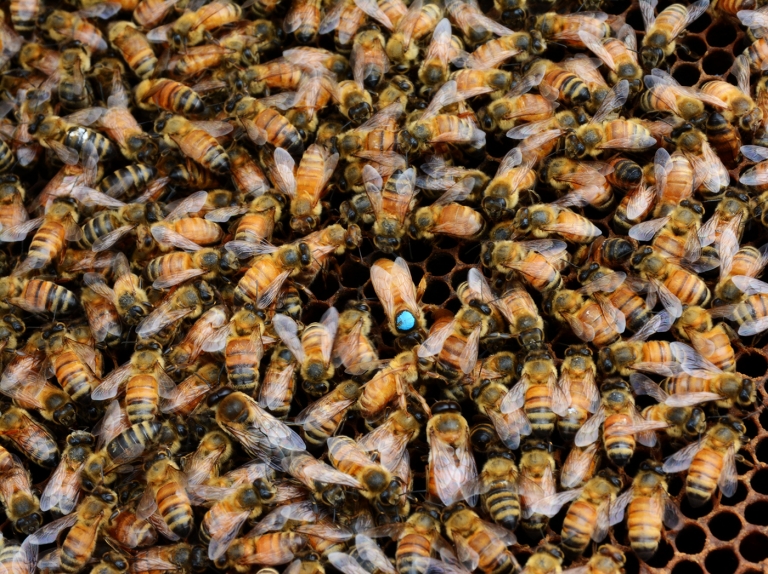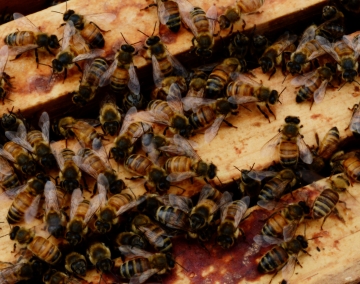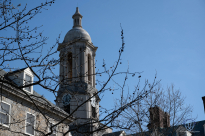Busy as a ...
On a warm and cloudy Tuesday afternoon in mid-April, Mario Padilla walked from his office in the Chemical Ecology Lab on Orchard Road at Penn State to a honey bee apiary, about 100 yards down the hill.
He put on a beekeeping veil — an off-white jacket with a netted, enclosed hood — readied his smoker, a foot-long contraption that looks like a camping tea kettle with an attached bellows to pump the smoke out, and opened the electric fence that surrounds the apiary.
The fence is to keep bears out.

With Beaver Stadium towering above the horizon three-quarters of a mile away, Padilla, a research technologist who graduated with a master’s degree in entomology from Penn State in 2014, walked through an area of yellow, pale blue and purple wooden boxes stacked on top of each other, about two feet tall — Langstroth hives. Each hive houses a colony, and hundreds of thousands of honey bees were buzzing around – “installed” in 15 hives the week before.
Padilla slowly, carefully opened the lid to each hive. As he performed the task, honey bees flew out, and he squeezed the bellows of the smoker, releasing gray plumes of smoke to keep the colonies calm.
“I just love their behavior. I love watching the bees,” Padilla said.
He didn’t wear gloves — not only to allow for dexterity of movement, he said, but also to make himself conscious of being delicate with the bees. He removed each frame from the hive to check for the queen. The frames contain the cells where the queen lays her eggs. Worker bees also store honey and pollen in these cells — cells full of honey are called honeycomb. He was looking to see if the queen had laid any eggs and to make sure the bees were doing well.
Each hive has its own queen, and he checked each hive.
Occasionally, a bee would land on him, but Padilla said the slower and easier he is with the bees, the less he has to worry about getting stung.
During what he called “field season,” when it’s warm enough for the bees to come out of the hive and forage for food, a period that typically lasts from April to October, Padilla said he’ll probably spend 20 to 25 hours per week outside with the bees.
**********
Researchers and research technologists like Padilla aren’t the only people spending their days on the lives of bees.
About a mile away, Medora Ebersole, education and community programs manager at the
Center for the Performing Arts at Penn State, spends much of her time thinking about bees and other pollinators. A citizen scientist, she spearheads something called Pollinator Corridors, which encourages people with phones to look for bees and record their observations about the pollinators.
Pollinators are animals that pollinate flowers. Besides bees, pollinators include butterflies, bats and birds. Ebersole said she wants to provide an outlet for people to track their observations about pollinators at places such as gardens. She said she hopes people will be able to use the data they collect to help these creatures.
Honey bees are vital to the environment and the food chain, pollinating the crops that people love to eat. But bees are struggling, and researchers and lay people are concerned.

Across the country scientists are trying to figure out why bee populations are in trouble and what can be done to remedy the problem. Researchers at Penn State are working on everything from the effect of pesticides on honey bees to how different so-called stressors, such as parasites and viruses, affect bees.
Non-scientists are getting into the act as well, turning their admiration for beekeeping into a hobby that can shed valuable information.
In fact, it was a Pennsylvania beekeeper who, nearly a decade ago, discovered what is now called colony collapse disorder, a syndrome in which adult worker bees in a colony will mysteriously disappear. The disorder alarmed scientists and prompted governments, universities and everyday hobbyists to look for signs that might be contributing to the problem.
With colony collapse disorder, the queen, several young workers and the brood — eggs and larvae — are left alive, but much of the adult population disappears. And the bees are not lying dead outside the colony.
“There are a lot of things that could potentially contribute to colony collapse disorder, and we don’t know what exactly causes it,” said Holly Holt, a graduate student studying entomology and an outreach coordinator for the Center for Pollinator Research at Penn State. “Right now the general consensus is that basically it’s probably a lot of different things. … What causes colony collapse disorder in one instance might differ from what causes colony collapse disorder in another instance.”
While media across the country have latched onto colony collapse disorder as the reason bees have been dying, many researchers aren’t concerned only with colony collapse disorder, said Jim Frazier, Penn State professor emeritus of entomology.
It’s important to mention that honey bees have a lot of other things that kill them, Holt said.
There are major stressors that contribute to global declines in pollinators — parasites and pathogens, pesticide exposure, poor nutrition and habitat destruction, as well as larger factors, such as global warming and climate change, Holt said.
In May 2014, the Apiary Inspectors of America and the U.S. Department of Agriculture, working with a collaboration of research labs and universities called the Bee Informed Partnership, released its annual survey on the health of bee colonies. The survey said that 23.2 percent of managed honey bee colonies, practically a quarter of all colonies in the U.S., were lost during the 2013-2014 winter season.
But that was good news. Over the 2012-2013 winter, the loss was 30.5 percent.
Though the most recent statistics were greeted with some relief, the actual numbers lost colonies remain higher than what beekeepers consider an acceptable loss percentage.
**********
Researchers at Penn State are looking at pollinators from all different angles, trying to understand and deal with various factors that are causing honey bee population declines.
For many of these scientists, it’s more than work – it’s a passion.

Padilla works in the laboratory of Christina Grozinger, a professor of entomology and director of the Center for Pollinator Research at Penn State, which was started in 2009 to bring together various efforts in research, education and outreach dealing with pollinators.
With more than 25 faculty members — plus students, technicians and researchers working with them — the center “ends up being, by far, the largest group of people working on pollinators in the world,” Grozinger said. “So, we’re really … well-positioned to deal with pollinator issues.”
Grozinger’s lab is split between people working on social behavior and communication of bees and people working on the physical health of bees.
One recent project looked at bees’ genes and molecular responses to different stressors.
Researchers looked at parasites, pesticides and viruses to see if there were common genes and physiological pathways that were activated.
Grozinger recently published a paper showing that with viruses there was an unexpected pathway that hadn’t been seen in other species.
If researchers can understand more how these stressors affect bees, she said, they can figure out what will make bees more resilient if they’re exposed to the stressors and what management practices beekeepers could use to help the bees survive.
On the social behavior side, Grozinger said her lab has looked at how queen honey bees signal their mating status to drones — male bees.
“The queen is actually really promiscuous,” Grozinger said.
The queen usually mates with about 12 males, and it’s been found that this produces a healthier and more productive colony because it’s genetically diverse, she said.
Grozinger’s lab has looked at the queen’s pheromones — a chemical secreted that can indicate different things to other bees. They found that the queen has some pheromone components that aren’t affected by mating, but simply signal that she’s a queen. She also has a gland that changes dramatically if she’s mated, and another gland that indicates how well she’s mated, Grozinger said.
If the queen is inseminated with a higher volume — meaning by more males — or with semen versus saline, then she’ll produce a different blend of pheromones and the workers respond better to that blend when looking at their behaviors, she added.
“So it’s actually kind of more like a language than just this simple … signal response kind of thing. It’s really very nuanced,” Grozinger said.
She’s also beginning a new project — her team has gotten funding from the USDA Animal and Plant Health Inspection Service to start collecting bees from all over the world to screen for new viruses.
Meanwhile, Nancy Ostiguy, an associate professor of entomology, is working on figuring out if bees are more susceptible to other pathogens when they’ve been exposed to pesticides.
Ostiguy and her collaborators, at other universities, collected samples over four years of the bees, pollen and wax from colonies in Florida, Texas, Washington, Minnesota and Maine, in addition to Pennsylvania.
Now they are trying to figure out what the data tells them, she said.
During the study, they detected 80 different pesticides, but not all of the pesticides were found in all locations, she said.
“We tend to think of pesticide exposures as being this uniform exposure level, and from the data that we have, it’s very episodic,” she said. “Most of the pesticides that we detected were only detected in one month each year. And there were differences by year [and] between the pesticides that were evaluated.”
Something unique about their study — Ostiguy said she doesn’t believe it’s been done in non-humans — is that they divided pesticides based on whether they were fungicides, herbicides or insecticides. Then they divided them by how they actually work inside the organism.
Jim and Maryann Frazier, senior extension associate with a specialization in honey bees in the Entomology Department at Penn State, and Chris Mullin, Penn State professor of insect toxicology, are focusing on pesticides, too. But in a different way.
The team is looking at the mixing of chemicals, particularly formulation ingredients — all the other things aside from the active ingredient listed on the pesticide — put into a pesticide that make the product work and allow it to be more stable and useful wherever it’s going to be applied, said Mullin.
In particular, the team is looking at the sub-lethal effects of pesticides on honey bees.
A sub-lethal effect is when a pesticide doesn’t kill the bees immediately, but it interferes with their normal physiology and behavior, Jim Frazier said.
For example, a honey bee could leave the hive to forage for food and, because of pesticide exposure, become disoriented and not be able to find its way back, he added.
**********
About 185 miles northwest of Penn State, Charlie Vorisek, president of the Pennsylvania State Beekeepers Association, tends to his bees.
Vorisek, of Linesville, Pennsylvania, has been keeping bees for about 22 years. What started as helping his daughter with a Future Farmers of America project grew into his life’s vocation.
Vorisek works with the bees between April and October. He’s out nearly every day, often working from 6 a.m. to 9 or 10 p.m.
Vorisek moves his bees between various crops, including cherries, apples, blueberries, strawberries and buckwheat. While the bees are pollinating these crops, there isn’t a surplus of honey for him to sell, which is why he said he charges a pollination fee.
He said the bulk of honey production happens during three or four weeks in June and from late August to late September.
All of his honey is sold locally.
Vorisek is a full-time beekeeper, but many beekeepers in Pennsylvania aren’t.
Of the roughly 3,500 registered beekeepers in the state, 84 percent have 10 hives or fewer — the majority are hobbyists or backyard beekeepers, he said.
A few years ago, beekeepers in Pennsylvania were at an all-time low of around 2,000, he said. Beekeeping used to be limited mostly to rural areas, but there’s been a movement for urban and suburban beekeepers.
With losses of honey bees, people have taken a new interest, he said.
“Some people are doing it for the sake of the bees,” he added.
And this is where people like Ebersole with her pollinator project comes in.
Ebersole’s idea for the Pollinator Corridors came from a constellation of things, she said.
She had traveled to Bolivia and Peru where she came up with the idea that people could collect data about pollinators on their cell phones and then using the data in their communities.
Ebersole said she thinks the project could work anywhere and is looking forward to testing it out in central Pennsylvania.
In addition to the texting part of the project, Ebersole has also worked with a team at Penn State to create an app called Honeycomb that uses the same idea for gathering observations.
People will answer various questions, such as “What kind of pollinator is it?” “What kind of plant is it?” and “What’s the weather like?”
“My background is in the arts, and in arts you do a lot of observing … so that’s the crossover with the sciences,” she said. “The idea of migratory flyways and pollinator corridors — that’s a very … creative, visual kind of artistic thing … and pollinators themselves are just beautiful.”
Urban and suburban beekeeping is becoming more popular. With major cities like New York legalizing the practice, many people are taking up the hobby.
The Pennsylvania State Beekeepers Association is working with local municipalities to try to smooth this transition. Many municipalities forbid beekeeping, because they’re not zoned for agricultural activity — and because some citizens view bees as a nuisance, Vorisek said.
“I feel like backyard beekeeping might be the future of beekeeping, not so much the commercial beekeeping that you see these days,” said Victoria Triolo, a junior plant sciences major who is leading the newly established Penn State Beekeepers Club.
“Beekeeping teaches you a lot about the environment,” she added. “It teaches you a lot about how one part of the environment affects another.”
Maryann Frazier said it’s no surprise that non-scientists are becoming more involved in the future of bees.
Pollinators are something people see as part of their environment — butterflies, birds, bees. When these things start to disappear, people notice that and get concerned, she said.
It’s a cause that people have become passionate about, Triolo said.
There’s been a lot of public response to what’s happening with the bees — more people becoming beekeepers and people are being more careful about what they’re doing, even establishing pollinator gardens, Maryann Frazier said.
“We have the opportunity,” she said, “to reverse the trend with honey bees.”








